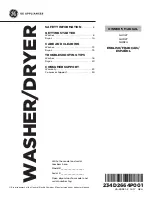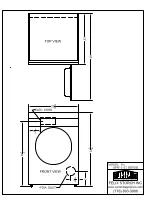
NOTE:
Using a detergent that is not specifically designed for
dishwashers will cause the dishwasher to fill with suds. During
operation, these suds will spill out of the dishwasher vents,
covering the kitchen floor and making the floor wet.
Because so many detergent containers look alike,
store the dishwasher detergent in a separate space
from all other cleaners. Show anyone who may use
the dishwasher the correct detergent and where it
is stored.
While there will be no lasting damage to the
dishwasher, your dishes will not get clean using
a dishwashing detergent that is not formulated
to work with dishwashers.
Consumer Support
Tr
oubleshooting T
ips
Operating Instructions
Safety Instructions
5
Using the dishwasher.
www.AmericanaAppliances.com
Filling the Dispenser
Fill the rinse agent dispenser until it reaches the
bottom of lip inside the opening. Replace cap.
To check if rinse agent is needed, remove the cap
and look into the dispenser.
A full dispenser should last about one month.
If rinse agent spills, wipe up the excess.
Check the Water Temperature
The entering water must be at least 120°F and
not more than 150°F, for effective cleaning and to
prevent dish damage. Check the water temperature
with a candy or meat thermometer.
Turn on the hot water faucet nearest the
dishwasher, place the thermometer in a glass and
let the water run continuously into the glass until
the temperature stops rising.
Use Jet-Dry
®
or Cascade Rinse Aid
®
Rinse Agent
Proper Use of Detergent
Jet-Dry
®
or
Cascade Rinse Aid
®
rinse agent removes spots and prevents new film buildup on your dishes,
glasses, flatware, cookware and plastic.
Use only detergent specifically made for use in
dishwashers.
Cascade
®
, Cascade
®
Complete
and
Electrasol
®
Automatic Dishwashing Detergents have
been approved for use in all dishwashers. Keep your
detergent fresh and dry. Don’t put powder detergent
into the dispenser until you’re ready to wash dishes.
The amount of detergent to use depends on
whether your water is
hard
or
soft
. With hard water,
you need extra detergent. With soft water, you need
less detergent.
Protect your dishes and dishwasher by contacting
your water department and asking how hard your
water is. Twelve or more grains is extremely hard
water. A water softener is recommended. Without
it, lime can build up in the water valve, which could
stick while open and cause flooding. Too much
detergent with soft water can cause a permanent
cloudiness of glassware, called
etching
.
You’ll find two detergent dispensers on the inside
door of your dishwasher. All wash cycles require
detergent in the main cup. Wash cycles with two
washes will also use the open cup. When using
automatic dishwashing detergent tabs, simply place
one tab in the main cup and close.
Be sure the Dial is
OFF
before adding detergent.
Otherwise, the detergent cup will not close and
latch properly. Add detergent then close the
main cup.
NOTE:
To open detergent cup after it has been closed,
simply turn the detergent cup handle counterclockwise
until it releases. A snapping sound may be heard.
Open cup
Main cup
DO NOT USE HAND DISH DETERGENT


































